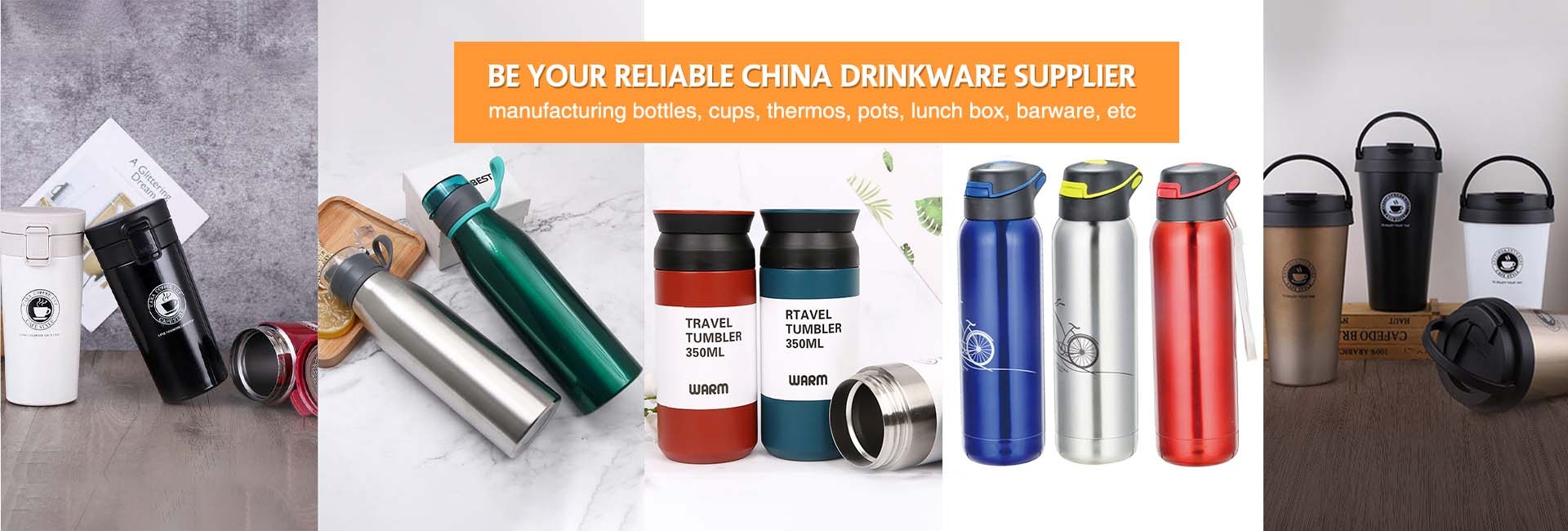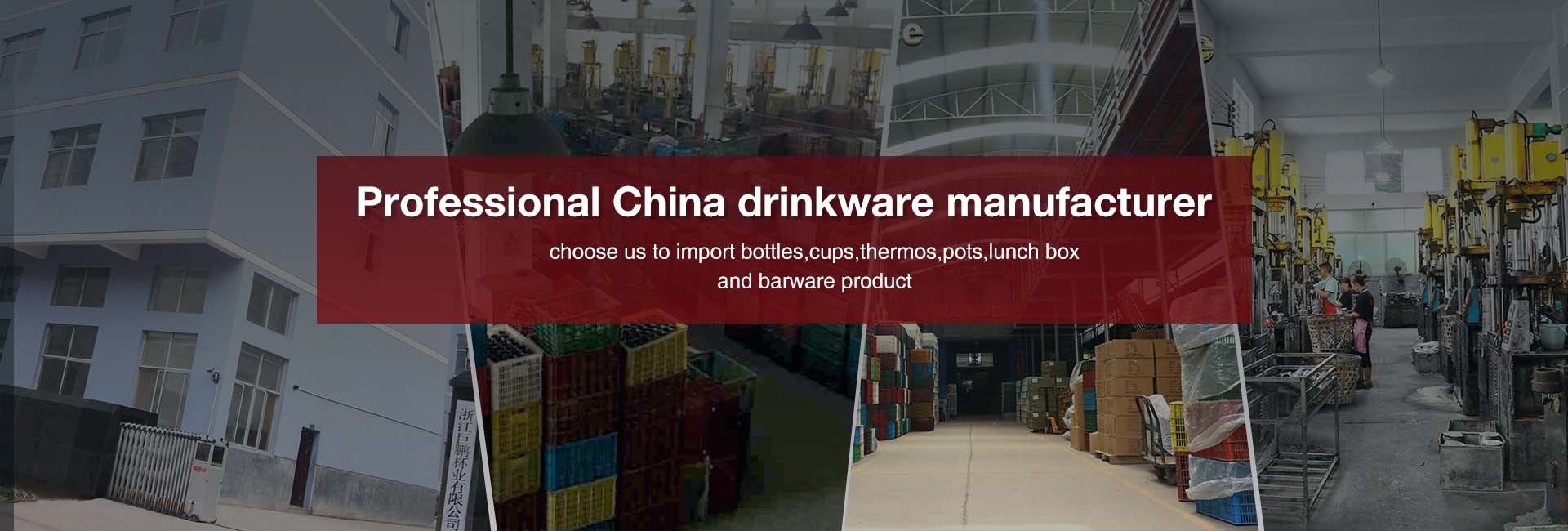The thermos cup is the core product of Zhejiang Jupeng Drinkware Co., Ltd.
Jupeng’s thermos cup has good quality and good reputation.It has been widely praised in various countries in the global market.It is one of the core suppliers in the thermos cup industry.
Customers familiar with stainless steel thermos cups know that the thermos cup is characterized by a cover on the top and tight sealing.The vacuum insulation layer can delay the heat dissipation of water and other liquids installed inside, so as to achieve the purpose of heat preservation.The thermos cup is developed from the thermos bottle.The heat preservation principle is the same as that of the thermos bottle, but people make the bottle into a cup for convenience.There are three ways of heat transmission: radiation, convection and transmission.The silver cup liner in the thermos cup can reflect the radiation of hot water.The vacuum of the cup liner and the cup body can block the transfer of heat, while the bottle that is not easy to transfer heat can prevent heat convection.
As for the production process of thermos cup, there are more than 50 processes.Let’s talk about the production process of thermos cup, the mechanical equipment used in each process and the key points for production.
Production process flow chart
1.Shell processing flow
Outer pipe picking → pipe cutting → water expansion → segmentation → bulging → middle corner rolling → bottom shrinking → bottom cutting → reinforcement → flat upper mouth → bottom flushing → flat bottom mouth → cleaning and drying → inspection and pit knocking → qualified shell
2.Inner shell processing process
Inner pipe picking → pipe cutting → flat pipe → bulging → corner rolling → flat upper mouth → flat bottom mouth → thread rolling → cleaning and drying → inspection and pit knocking → butt welding → water test and leakage detection → drying → qualified inner tank
3.Shell and inner shell assembly process
Cup mouth → welded junction → pressing midsole → bottom welding → inspecting welded junction and bottom welding → spot welding getter of midsole → vacuumizing → temperature measurement → electrolysis → polishing → temperature measurement → inspection and polishing → pressing outsole → painting → spot inspection and temperature measurement → inspection and painting → silk screen printing → packaging → warehousing of finished products
Brief description of production process
1.Pipe cutting: the lathe shall be used, and the specific implementation shall be in accordance with the pipe cutting operation instruction.The size shall be accurate, and the defective products shall be found in time
For waste materials, pits, pits, pits and waste products shall be avoided during operation.
2.Water expansion: the water expansion press shall be carried out in accordance with the water expansion operation instruction.Attention shall be paid to whether the pit, size and shape of the product meet the requirements.
3.Segmentation: cut off the two shells of water expansion one and two with an instrument car.The size shall be accurate, and the cutting opening shall be uniform and free of defects
Handle mouth and burr with care to avoid pits and waste products.
4.Bulging: use a large press, which can be carried out in accordance with the water expansion operation instruction.It is required to pay attention.The welding position of the pipe of the shell should correspond to the joint of the mold, and always pay attention to whether the pit, size and shape of the product meet the requirements.
5.Rolling middle angle: use a lathe to roll the two corners at the concave shape of the bulging shell to meet the size requirements, and avoid pits and waste products.
6.Bottom shrinking: use a lathe, which shall be implemented in accordance with the necking operation instruction.Shrink the circular arc bottom opening of the bulging shell to meet the size requirements to avoid pits and waste products.
7.Bottom cutting: use a lathe to cut the bottom opening of the shell that has shrunk over the bottom to the standard size.The cutting opening is uniform, free of notch, burr and light handle with care to avoid pits and waste products.
8.Punching: flatten the welding joint at the shell opening on a small press, so that the welding will not skip during the welding, so as to make the welding joint smooth and uniform.
9.Shell flat upper mouth: use a lathe, the flat mouth is uniform, without notch and burr, meets the requirements, and is handled with care to avoid damage pits, scrap.
10.Bottom punching: use a press to pay attention, always pay attention to whether the pit, size and shape of the product meet the requirements, and pay special attention to whether there are cracks at the bottom of the punching.
11.Flat bottom opening: the instrument car shall be used.The flat bottom opening shall be uniform without notch and burr.It shall meet the requirements.It shall be handled with care to avoid production pits, pockmarks and waste products.
12.Flat pipe: use an instrument car to level one end of the pipe orifice.The flat orifice is uniform without notch and burr, which meets the requirements; handle gently,avoid pits, and waste products.
13.Roll up the corner: roll the bulge corner of the bulged inner tank to meet the size requirements with a lathe, and handle it gently to avoid production pits, pockmarks and waste products.
14.The flat upper mouth of the inner tank: use the instrument car, and the flat mouth is uniform without notch and burr, which meets the requirements; Handle with care to avoid childbirth pits, pockmarks and waste products.
15.Thread rolling: a special thread rolling machine shall be used, which shall be implemented in accordance with the thread rolling operation instruction, requiring attention,adjust the thread depth to meet the size requirements; Handle with care to avoid pits and waste products.
16.Cleaning and drying: clean the inner tank and shell and dry them; Handle with care to avoid pits and hemp ,
Point and report waste products.
17.Inspection and pit knocking: check whether the inner tank and shell are qualified.If there are pits and pits, knock them to meet the requirements and take them gently
Let go.
18.Butt welding: butt weld the inner liner and the inner bottom according to the butt welding operation instruction, and the welding required
The joint shall be smooth without holes and pits.
19.Water test and leak detection: inflate the butt welded inner tank for water test, and check whether there are loopholes in the weld.If there is no leakage, it is qualified.
20.Cup mouth: put the inner liner and shell together, and the cup mouth is flat; Handle with care to avoid pits and hemp
Point and report waste products.
21.Bottom welding of welded junction: it shall be carried out in accordance with the operation instructions for bottom welding process of welded junction.It is required to ensure that the bottom of welded junction is fully welded and round
Smooth, without bump, weld bead and missing weld.
22.Spot welding: spot weld the getter on the midsole.Note that the getter on the spot welding must be vacuumized within 24 hours ,That’s good, or it won’t work.
23.Press the midsole: press the cup with welded mouth on the midsole with spot welding getter, and press it flat with the bottom mouth.
24.Inspection of welded junction and bottom: inspect the cup with welded junction bottom to find out whether there is missing welding, poor cup junction welding or other defects a cup of good reason.
25.Vacuum pumping: tail less vacuum pumping shall be carried out in strict accordance with the vacuum pumping operation standard.
26.Temperature measurement: according to the operation instructions for electric temperature measurement process, check whether the cup is vacuum and pick out the non vacuum cup.
27.Electrolysis: send it to outsourcing electrolysis.The electrolysis in the cup is required to be bright and uniform without watermark and yellow dot.
28.Polishing: the cup shell shall be polished finely with orderly lines, the cup mouth shall be smooth and bright, and there shall be no obvious wire drawing, scratch black wires, pits and polishing paste residues.
29.Inspection and polishing: whether the polished cup meets the requirements.If it is not good, it shall be polished again, and the good will flow to the next process.30.Press the outsole: press the outsole on the polished cup, which is required to be flattened.
31.Painting: send it to the outsourcing for painting.The color is the same.The painting is required to be uniform and firm without paint falling, pitting, etc.
32.Inspection of painting: check whether the cup after painting meets the painting requirements.If it is not good, it shall be repainted and polished, and if it is good, it will flow to next process.
33.Silk screen printing: the trademark logo shall be printed on the silk screen as required, which shall be clear, and the pattern mark, size, color and position are like the sample;
The silk screen printing label can’t be stuck with a plastic bag and can’t be easily buttoned with a nail, so it must be baked with a drying channel after silk screen printing.
34.Packaging: refer to the product packaging standard operation manual for details.
Main mechanical equipment
1.Lathe
2. Hydraulic press
3. Water test leak detector
4. Oven machine
5. Argon arc welding machine
6.Tail vacuum extractor
7. Tailless vacuum extractor 8 meter
Post time: Feb-04-2022


